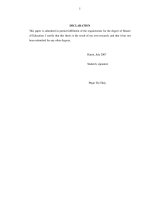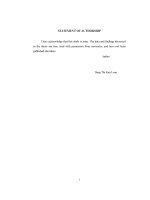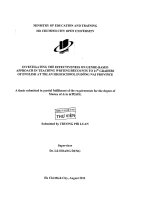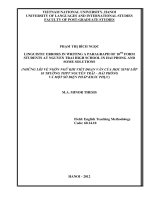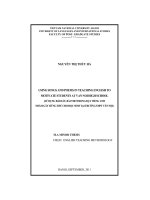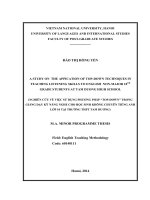USING INDIRECT CORECTIVE FEEDBACK ON STUDENTS’ WRITING TO IMPROVE WRITING SKILLS FOR GRADE 10TH MIXED LEVEL STUDENTS AT VAN NOI HIGH SCHOOL IN DONG ANH, HANOI AN ACTION RESEARCH
Bạn đang xem bản rút gọn của tài liệu. Xem và tải ngay bản đầy đủ của tài liệu tại đây (1.67 MB, 67 trang )
VIETNAM NATIONAL UNIVERSITY-HANOI
UNIVERSITY OF LANGUAGES AND INTERNATIONAL STUDIES
FACULTY OF POST GRADUATE STUDIES
------------------------
NGUYỄN THI ̣QUỲ NH THU
USING INDIRECT CORECTIVE FEEDBACK ON STUDENTS’
WRITING TO IMPROVE WRITING SKILLS FOR GRADE 10TH
MIXED LEVEL STUDENTS AT VAN NOI HIGH SCHOOL IN
DONG ANH, HANOI- AN ACTION RESEARCH
(VIỆC SỬ DỤNG VIỆC SỬA LỖI GIÁN TIẾP ĐỂ CẢI THIỆN KỸ NĂNG
VIẾT CHO HỌC SINH LỚP 10 CÓ TRÌNH ĐỘ KHÁC NHAU TẠI
TRƯỜNG THPT VÂN NỘI, ĐÔNG ANH, HÀ NỘI, MỘT NGHIÊN CỨU
HÀNH ĐỘNG)
M.A MINOR PROGRAMME THESIS
Field: English Teaching Methodology
Code: 60140111
HANOI – 2017
VIETNAM NATIONAL UNIVERSITY-HANOI
UNIVERSITY OF LANGUAGES AND INTERNATIONAL STUDIES
FACULTY OF POST GRADUATE STUDIES
------------------------
NGUYỄN THI ̣QUỲ NH THU
USING INDIRECT CORECTIVE FEEDBACK ON STUDENTS’
WRITING TO IMPROVE WRITING SKILLS FOR GRADE 10TH
MIXED LEVEL STUDENTS AT VAN NOI HIGH SCHOOL IN
DONG ANH, HANOI- AN ACTION RESEARCH
(VIỆC SỬ DỤNG VIỆC SỬA LỖI GIÁN TIẾP ĐỂ CẢI THIỆN KỸ NĂNG
VIẾT CHO HỌC SINH LỚP 10 CÓ TRÌNH ĐỘ KHÁC NHAU TẠI
TRƯỜNG THPT VÂN NỘI, ĐÔNG ANH, HÀ NỘI, MỘT NGHIÊN CỨU
HÀNH ĐỘNG)
M.A MINOR PROGRAMME THESIS
Field: English Teaching Methodology
Code: 60140111
Supervisor: NGUYỄN THI ̣MINH TÂM , Ph.D
HANOI – 2017
DECLARATION
I certify that this minor thesis entitled “Using indirect corrective feedback on
students ‘writing to improve writing skill for grade 10th mixed level students at
Van Noi high school in Dong Anh, Ha Noi-An action research” is the study of my
own research and the substance of this research has not been submitted for a degree to any
other university or institution.
Hanoi, April, 2017
Signature
Nguyễn Thi Quy
̣
̀ nh Thu
i
ACKNOWLEDGEMENTS
I would like to express my gratitude to all those who have given me great
assistance in the completion of my research work.
In the first place, I would like to express my deepest gratitude to my supervisor
Nguyen Thi Minh Tam, Ph.D, who has provided me with insightful discussion,
helpful comments, valuable support in the preparation and completion of this thesis.
Without her guidance and help, this work would not have been accomplished.
Secondly, my sincere thanks also go to all lecturers and staff of the department
of Post- Graduate studies for their valuable lessons and precious helps. Thanks to
their lessons as well as needed helps, I could overcome enormous obstacles when
doing the study.
I also wish to acknowledge the cooperation of my colleagues and the students at
Van Noi high school in contributing to the data collection presented in this study.
Last but not least, I would like to express my deepest thanks to my family for
their encouragement and great support during my time of fulfilling this thesis.
ii
ABSTRACT
Most second language learners encounters difficulties when writing in the
target language. For the students at Van Noi high school, the problem might be
serious. Because of their different and especially low levels when entering this
school, the students found it difficult to master writing skill in English. In order to
solve the problem, students need to understand the nature of writing as well as the
detailed instructions from the teacher. As a result of this, this project was set out to
help the students improve their writing skill using indirect corrective feedback
(ICF). The research was formulated as an action one which used a questionnaire,
interviews and writing assignments as research instruments to collect quantitative
and qualitative about the students‟ attitudes and the effectiveness of using ICF in
teaching and learning writing. As can be seen from the qualitative and quantitative
data, difficulties, limitations and challenges still occurred during the research;
however, to some extent, the students‟ writing was also improved. The results
suggested the use of ICF as one of the effective ways to teach and learn writing in
English.
iii
TABLE OF CONTENTS
DECLARATION ........................................................................................................................... i
ACKNOWLEDGEMENTS ....................................................................................................... ii
ABSTRACT .................................................................................................................................. iii
TABLE OF CONTENTS .......................................................................................................... iv
LIST OF ABBREVIATIONS .................................................................................................. vi
LIST OF TABLES ..................................................................................................................... vii
INTRODUCTION ..................................................................................................................... 1
1. Background to the study and statement of problem .........................................1
2. Aim of the study................................................................................................2
3. Research question .............................................................................................2
4. Scope of the study .............................................................................................2
5. Significance of the study ...................................................................................3
6. Organization of the study ..................................................................................3
CHAPTER 1: LITERATURE REVIEW .......................................................................... 4
1.1.
Learning and teaching writing skill in English as a foreign language ..........4
1.2.
Types of CF in writing...................................................................................4
1.3.
Teacher‟s ICF feedback in writing ................................................................7
1.4.
Effects of ICF on students' ESL/EFL writing ...............................................9
1.5.
A brief review of previous studies on CF ......................................................9
Summary ....................................................................................................................................... 13
CHAPTER 2: METHODOLOGY ..................................................................................... 14
2.1. Rationale for the use of Action research.........................................................14
2.2. Context of the study ........................................................................................16
2.3. Subjects ...........................................................................................................16
2.4. Research instruments ......................................................................................17
2.4.1. The researcher’s analysis of the students’ writings (See Appendices for
more detail) ........................................................................................................17
iv
2.4.2.
A semi-structured Interview ..................................................................17
2.4.3. A survey questionnaire (See Appendices for more detail) .......................19
2.3.4. Research procedures ................................................................................19
2.3.5. Data analysis ............................................................................................23
CHAPTER 3: FINDINGS AND DISCUSSION ............................................................ 24
3.1. Findings ..........................................................................................................24
3.1.1. Findings from the researcher’ analysis of the students’ writings ............24
3.1.2. Findings from interview with the students ...............................................26
3.1.3. Findings from the student questionnaire ..................................................30
3.2. Discussion of the findings ..............................................................................33
CONCLUSION .......................................................................................................................... 35
1. Recapitulation ....................................................................................................35
2. Implication of the study .....................................................................................36
3. Limitations of the study .....................................................................................36
3. Suggestions for further study .............................................................................37
REFERENCES .......................................................................................................................... 38
APPENDICES .............................................................................................................................. I
v
LIST OF ABBREVIATIONS
S:
Student
CF:
Corrective feedback
DCF:
Direct corrective feedback
EFL:
English as Foreign Language
ELT:
English Language Teaching
ESL:
English as Second Language
ICF:
Indirect corrective feedback
WS:
Writing Session
L2:
Second language
vi
LIST OF TABLES
Table 1.1: Types of Feedback ..................................................................................... 5
Table 1. 2: Error code.................................................................................................. 8
Table 1.3: Review of previous studies on corrective feedback ................................ 10
Table 2.1: Schedule for five in-class writing sessions .............................................. 22
Table 3.1. Reliability Statistics of items included in the questionnaire .................... 24
Table3.2. The percentage of students‟ attitudes towards ICF regarding detailed
questionnaire clusters ................................................................................................ 31
vii
INTRODUCTION
1. Background to the study and statement of problem
Second language (L2) writing has always been a hot topic for second
language researchers. The emergence of the field of L2 writing is a relatively recent
phenomenon, but it has come of age. Historically speaking, the field of L2 writing
originally focused on the teaching of writing to the increasing population of
international ESL writers at institutions of higher education in North America in the
late 1950s and the early 1960s. Over around the last 50 years, the number of
inquiries into L2 writing issues have grown rapidly and produced fruitful results.
Although the outstanding work provides invaluable insights, a comprehensive
review of major issues and the relevant findings in L2 writing is still in a small
number. As an effort to address this lack, this paper aims to retrospectively provide
a relatively comprehensive and systematic overview of the development of L2
writing research and to summarize the unsolved problems so as to inspire future
studies. Due to quite varied research interests of individual researchers, it will not
be possible neither necessary for us to report every study in great detail. So, in this
research, a review of the studies on the major topics in the five areas of L2 writing
research and their findings will be presented, which, we firmly believe, will help
those inexperienced L2 writing researchers and those interested in this field of
inquiry to know better about the development of L2 writing research. Also, based
on the existing literature, we will propose a few unsolved problems which require
further discussion.
At Van Noi High School, writing is not being taught as a single subject in the
English curriculum; yet it is treated as a skill integrated with all other skills
supporting a specific theme or topic in each unit in the course book. In fact, as
observed from the author‟s teaching experience, when dealing with a writing
assignment, the students at Van Noi High School do not often struggle with ideas
since a number of language activities and skills supporting the writing topics
have been conducted as pre-writing tasks preceding the students‟ self-written
compositions in every unit. Then the major problem relatively prevalent among
the students falls into their language use which is indicated by their grammatical
1
errors, lexical choice errors and mechanics errors; as a result of these errors,
writing accuracy as well as the quality of the students‟ written work has been
considerably diminished.
Facing these afore-stated issues, a number of strategies have been introduced
in teachers‟ writing instruction; however, treating the students‟ language errors in
their written documents, or giving corrective feedback (CF), is regarded as the
most preferable tactic used by teachers at Van Noi High School. In fact, direct
CF has been commonly used to deal with errors in the students‟ written work,
whereas indirect corrective feedback (ICF) has not been considerably exploited
by the English teachers. Sparking from the reality, the author of this paper wishes
to carry out an action research entitled: “Using indirect corrective feedback on
students ‘writing to improve writing skill for grade 10th mixed level students at
Van Noi high school in Dong Anh, Ha Noi-An action research” to investigate
how ICF strategy may affect the students‟ writing accuracy and skill
improvement as well as their attitudes towards their teacher‟s use of ICF in
writing. A number of recommendations involving the use of teacher‟s ICF in
writing tasks will also be withdrawn in this research.
2. Aim of the study
The aim of this study is to find out the extent to which the use of ICF on
students‟ writing helps to improve writing skill for grade 10th mixed levels of
students at Van Noi high school in Dong Anh, Ha Noi
3. Research question
This study is an attempt to investigate the students‟ attitude and behavior as
well as the effect of using ICF on the students‟ writing in order to help improve
their writing skill by answering the following question:
To what extent can the teacher’s ICF influence the writing skill of students at
Van Noi high school?
4. Scope of the study
The research was carried out on 15 grade 10th students of mixed levels at Van
Noi high school in Dong Anh, Hanoi. It would be challenging for this minor thesis
to cover all the aspects of writing. Therefore, the study only focuses on the
2
influence of using the ICF on the students‟ writing in some following aspects: verb
tenses/ tense, articles, preposition and spelling
5. Significance of the study
By bringing out the result of the influence of using ICF on the students‟ writing
at Van Noi high school in Dong Anh, Hanoi, the study hopefully will somehow
make the following contributions. First, the finding of the study may be served as
reference to EFL teachers to gear their teaching towards a more effective approach
to the teaching of writing. Second, the dissemination of findings could help me and
my colleagues to better our own teaching at Van Noi High School, as well as those
who are teaching English writing skill to high school students at other schools in
Vietnam with the same situation as at Van Noi High School.
6. Organization of the study
The study is organized into the following parts as follows:
INTRODUCTION presents the background and the statement of the problem
for conducting the study, aims of the study, research questions, the scope as well as
the significance of the study.
Chapter 1 – LITERATURE REVIEW - provides a theoretical framework for the
study, including process approach in ESL/EFL writing, writing accuracy, students‟ written
errors and teacher‟s ICF in ESL/EFL writing.
Chapter 2 – METHODOLOGY - deals with an overview of Van Noi High
School as well as English teaching and learning at the school, and then describes the
methodology used in the research including data collection instruments, participants,
the procedures employed to carry out the research.
Chapter 3 - FINDINGS AND DISCUSSIONS – reports and discusses the
findings of the study.
CONCLUSION summarizes the main issues that have been addressed in the
study, points out the limitations, draws pedagogical implications concerning the
research topic and suggests several solutions.
Following this chapter will be the REFERENCES and APPENDICES
3
CHAPTER 1: LITERATURE REVIEW
This chapter discusses the theory and research into the areas which form the
underpinnings for the present study: overviews of learning and studying writing
English as a foreign language, types of teacher’s corrective feedback and teacher’s
ICF in writing as well as a discussion of empirical studies on the use of ICF in
writing.
1.1. Learning and teaching writing skill in English as a foreign language
Writing is one of the most difficult skills that second-language (L2) learners are
expected to acquire, requiring the mastery of a variety of linguistic, cognitive, and
sociocultural competencies (Seyyed et al., 2015). Therefore many teachers attest,
teaching L2 writing is a challenging task as well.
Feedback on students‟ writings is integral to L2 instruction. Writing
feedback would help writing teachers know how well their students have done in
the writing assignments, which is considered one of the most important
responsibilities of writing teachers. For students, they also expect feedback in order
to know how well they have succeeded in their writing tasks and what they should
improve in their future writings. There are two sources that feedback is from in the
context of the writing classroom, namely L2 writing instructors and student peers
(Zhang, 2008).
1.2. Types of CF in writing
Feedback as a specific term is rather new in research. Early studies from
Behaviorist researchers around the 1950s and 1960s were more focused on error
prevention than error treatment. Errors should not be tolerated and at all times be
prevented. The claim was that errors could be habit-forming and if they were
allowed to exist, they would interfere with more preferable habits. If the students
responded incorrectly they were given CF. Only when the student practiced
responding correctly, learning would occur (Bitchener & Ferris, 2012).
Many
teachers and researchers – Ferris (1999) was one of the first – felt that Truscott´s
claim that “grammar correction is ineffective and potentially harmful and should
therefore be banned (Truscott‟s, 1996, p.118)” was premature and totally false.
4
Despite this consensus in the teacher profession, extensive research was needed to
be able to falsify this claim and to find out how feedback should be given in order to
have the greatest effect on students writing skill.
Feedback in general refers to that specific information teachers provide to
their students related to the task or learning process. The purpose is to fill in the gap
between what the student understands at the moment and what is aimed to be finally
understood (Hattie & Timperley, 2007). Furthermore a distinction has to be made
between ICF as the different effects of these two types of feedback is what is aimed
to be investigated. One easily understood definition of these two is: “While indirect
corrective feedback only consists of an indication of an error (i.e. by underlining the
error or providing an error code), direct error correction identifies both the error and
the target form” (Van Beuningen, 2008, p. 282). Therefore indirect correction of
errors is left to the student to find and correct (Zaman & Azad, 2012), while the
teacher provides the correct form in direct error correction (Ellis, 2009A).
Furthermore Ellis gives a brief explanation of all different corrective feedback (CF)
types that are being used in research. The types of feedback in the table 1.1 cover all
types used in the studies reviewed in this paper.
Some researchers report no significant difference between the direct and ICF.
In their research, Robb et al. investigate four types of feedback including direct
feedback and indirect feedback where the number of errors was given in each line
of text. However, the students‟ improvement in accuracy in Robb et al.‟s and Ferris
& Roberts‟s is considered only by the revised texts instead of by students‟ new
pieces of writing, which cannot provide adequate evidence of the long-term effect
of written CF on students‟ accuracy.
Table 1.1: Types of Feedback (Ellis, 2009a, p.98)
Type of CF
Description
1. Direct CF
The teacher provides the student with
the correct form.
2. ICF
The teacher indicates that an error
Exists
5
but
does
not
provide
the
correction.
A: Indicating + Locating the error
This takes the form of underlining and
use of cursors to show omissions in the
student´s text.
B: Indication only
This takes the form of an indication in
the margin that an error or errors have
taken place in a line of text.
3. Metalinguistic CF
The teacher provides some kind of
metalinguistic clue to the nature of the
error
A: Use of error code
Teacher writes codes in the margin (e.g.
ww = wrong word; art = article).
B: Brief grammatical Description
Teacher numbers errors in text and
writes a grammatical description for
each numbered error at the bottom of the
text.
4. The focus of the feedback
This concerns whether the teacher
attempts to correct all (or most) of the
students´ errors or selects one or two
specific types of errors to correct. This
distinction can be applied to each of the
above options.
A: Unfocused CF
Unfocused CF is extensive.
B: Focused CF
Focused CF is intensive
5. Electronic feedback
The teacher indicates an error and
provides a hyperlink to a concordance
file that provides examples of correct
usage.
6. Reformulation
This consists of a native speaker´s
reworking of the students´ entire text to
6
make the language seem as native-like
as possible while keeping the content of
the original intact.
1.3. Teacher’s ICF feedback in writing
The role and treatment of errors or CF has been viewed differently within
different theories of SLA. These differing views also have had an impact on the
research on corrective feedback in SLA and L2 writing. The following subsection
gives the different ways to give CF in L2 writing.
The type of feedback a teacher gives will no doubt affect how their students
approach the writing process, view feedback, and make revisions to their writing
(Hedgcock & Lefkowitz, 1996; Lockhart & Ng, 1995). In order to make this clear, a
number of L2 writing research studies have seen quite a wide range of features in
students‟ L2 written texts that teachers respond to, such as students‟ ideas, rhetoric
organization, grammar, word choices, spelling, and punctuation (Conrad &
Goldstein, 1999; Ferris, 1995, 1997; Ferris, Pezone, Tade & Tinki, 1997; Hedgcock
& Lefkowitz, 1994; Reid, 1994; Saito, 1994).
Teacher‟s ICF is a combined
strategy which embraces all the characteristics of the contained types in dealing
with written errors. Generally, teacher‟s ICF, as described in Bitchener and Ferris‟s
(2012), is the teacher‟s action of drawing students‟ attention to the locations of their
errors without providing corrections. In a more comprehensive way, Joe describes
the way a teacher implicit the existence of errors needed repairing in students‟
written work. Two preceding approaches to teacher‟s ICF relatively reveal the
nature of the assigned strategy, yet its description of teacher‟s operations has not
been clarified in the definitions. Conceptualized by Ellis (2006), ICF is defined as
the indication of the error without giving correction, and it can be done by teachers
by encircling, underlining, highlighting, writing cursors or using error codes near
the error of the text. In this regard, a brief review of error code being taken into
consideration can be illustrated in the following table.
7
Table 1. 2: Error code (adapted from Tribble [65, p.154])
No.
Error Types
Code
1
Word order
WO
2
Verb form
VF
3
Tense
T
4
Article
Art.
5
Pronoun
Pro
6
Preposition
Pre
7
Subject-Verb Agreement
S-V
8
Singular
Sing.
9
Plural
Pl.
10
Spelling
Sp.
11.
Punctuation
Pun.
12.
Fragment Sentence
Frg.
13.
Run-on Sentence
Ro.
14.
Word choice
WC
To make the concept clearer, Ellis (2009) also provides the comparative
consideration of another CF type which is always in pairs with ICF, namely teacher‟
direct corrective feedback (DCF). This type of CF draws students‟ attention to the
error and requires a solution to it; in other words, the teacher shows students where
the errors are and corrects these errors by supplying the correct form. Consequently,
based on the all ideas above, especially on Ellis‟s framework (2009), and
considering the scope of the research, it can be acknowledged that teacher‟s ICF is
the strategy in which errors are underlined, circled, highlighted, written with cursors
or marked with codes without teacher‟s direct correction in the process of writing.
Students will play a centered role in doing a writing task while teacher will act as an
indicator of students' errors. The author considers this the most appropriate
framework adopted as the working definition throughout the study.
8
1.4. Effects of ICF on students' ESL/EFL writing
Investigation into whether CF has effects on students‟ writing has involved a
great number of studies, yet there is also controversy among researchers about the
benefits of CF on ESL/EFL learners‟ written outcomes. Truscott concludes that all
error correction is unnecessary, ineffective, and even harmful since it diverts time
and energy away from more productive aspects of writing instruction. However,
other researchers advocate the usefulness of CF as well as ICF. The comparison
between the effectiveness of DCF and ICF may be informative for better
understanding about the effectiveness of ICF. Of all the studies that consider the
effectiveness of DCF and ICF, the reported results are somewhat contradictory.
Furthermore, although it is found in Chandler (2003) that students who
receive direct CF often perform better than students who receive ICF, Lalande
(1982) and Lee (2009) report more progress in accuracy for students whose texts are
indirectly corrected over those whose texts are directly corrected. In addition, it is
noted in Lalande (1982) that ICF caters “guided learning and problem solving”.
Therefore, ICF is considered more likely to lead to long-term learning.
All in all, the effectiveness of different kinds of CF is still argued by
different researchers. Together with the research supporting the use of DCF, there
are a great number of studies asserting the effectiveness of ICF. These studies
which conclude that DCF is more effective also agree that ICF can have effects on
students‟ problem-solving skill and their long-term learning.
1.5. A brief review of previous studies on CF
There have been a number of studies and articles regarding different issues
of CF such as comparing the effect of different types of written feedback or
comparing the effect of different types of written feedback with no feedback. In
order to match the aim of this study which examines the influence of ICF on the
students‟ writing in general and on specific types of errors, the researcher consulted
these following studies and scientific articles.
9
Table 1.3: Review of some related previous studies on corrective feedback
Organization
and
Author
Title
Chandler
Study
(1982)
investigation into Group 1: Correction of is
description
1:
An Study
1 Study 1: Correction
the efficacy of the grammatical
correction
errors Direct
grammatical and Group
Study
2:
2:
correction
Control and
Study
simple
2 underlining
An Group
1:
of
Direct errors
investigation into correction
how
significantly
and effective. Study 2:
of lexical
lexical errors.
Findings
are
significantly
error Group 2: Underlining superior
correction should and
be done
to
describing the types
description
of
error of
type
errors
reducing long-term
Group 3: Description error.
of
error
Direct
type correction is best for
Group 4: Underlining
Lalande(1982) An
accurate revision.
investigation Group 1: Direct error Learners
reported
into the effect of correction Group 2: advantage
two
types
for
of Indirect coding
indirect
for
feedback
written feedback
over
on the writing of
correction.
60
statistical difference
intermediate
German
FL
was
learners
between
error
No
reported
the
two
treatments
Van
An
investigation Group
1:
Beuningen et into the effect of corrective
al.(1979)
direct and indirect Group
10
Direct Direct and indirect
feedback feedback improved
2:
Indirect writing
accuracy.
feedback
on feedback Control 1: Direct
writing accuracy
Self-editing
but
corrective
no feedback
is
feedback Control 2: effective for better
No self-editing and no grammatical
feedback
accuracy
and
indirect feedback is
better
for
non-
grammatical
accuracy.
Ferris (2002)
An evaluation of
Grammar correction
Truscott‟s (1996)
should be used.
argument
on
grammar
correction
Ellis
al.(2008)
et The
effect
focused
of Group
1:
Focused Focused
and
and feedback on articles unfocused
unfocused
Group 2: Unfocused corrective
corrective
feedback
feedback
Control
Group
3: feedback improved
students‟
compared with no
accuracy
feedback.
difference
between
but
the
types
no
two
of
feedback. Teachers
should
provide
corrective feedback
to students.
Guénette
A review article
Teachers
(2007)
of
provide
studies
on
corrective
feedback.
11
should
corrective
feedback
Nguyen
Thi Effectiveness
of Group
1:
indirect The research shows
Khanh (2012) indirect corrective corrective feedback
feedback
in Group
2:
the
remarkable
direct improvement
on
English writing at corrective feedback
writing accuracy in
the
the
Faculty
English,
of
Hanoi
indirect
corrective
National
group
and their positive
University
of
attitudes
Education
towards
the use of teacher‟s
ICF in writing
Pham
Lan The
Anh (2011)
impact
of Group 1: using DCF
Students
in
indirect feedback Group 2: using ICF
experimental
on
condition
learners‟
grammatical
errors
in
many
EFL
the
commit
fewer
grammatical errors
writing classes
than
their
counterparts in the
control group when
errors are treated as
a single group. ICF
helps reduce more
error categories and
more errors in each
category, especially
those related to the
simple past tense.
It is obvious that all the studies and articles above focus on the effectiveness
of ICF in different educational setting. The common point of these studies is that
they were conducted with the support of experimental or quasi-experimental
method. Two groups – experimental and control – were administered with different
12
CF strategies, and their performance in two tests – pretests and posttest – will be
used to assess the degree of effectiveness. From all the studies as mentioned, the
research came to the hypothesis that ICF could have positive impact on students‟
writing skill. This action research, therefore, is conducted in order to find out the
extent to which ICF influence the writing skill of students at Van Noi high school.
With all of her expectation, the study brought about the most convincing and
consistent findings of ICF effects in writing in her educational setting.
Summary
To sum up, there have been a number of studies carried out to find if ICF was
the appropriate way to improve the students‟ writing when learning English as a
foreign language. The use of ICF has been considered as one of the effective strategies
in helping the students to recognize and correct their writing in English.
13
CHAPTER 2: METHODOLOGY
The purpose of the chapter is to present the specific plan of procedure of the
study. The chapter begins with the rationale of the use of action research, the
context of the study, and followed by participants of the study, research instruments,
methods of data collection and data analysis respectively.
2.1. Rationale for the use of Action research
Action research is described as “a small scale investigation by teachers on
specific classroom problems for the purpose of curriculum renewal and/or
professional development” (Field, 1997; LoCastro, 1994; Markee, 1996, Nunan,
1993 cited in Griffee (2012:109) ). According to Bassey (1998: 93), action research
is “an enquiry which is carried out in order to understand, to evaluate and then to
change, in order to improve educational practice”. That is, action research is
designed and conducted by teachers with the aim of improving their own teaching.
One significant feature of action research is context-specific (McDonough &
McDonough, 1997). In other words, an action research is usually carried out in a
specific classroom by a particular teacher in order to bring about a change in their
teaching and learning issues. As a teacher, I am aware that every teaching situation
is unique regarding content, student level, student skills and learning styles and
many other factors. Therefore, in order to enhance student learning, a teacher must
discover what work best in her particular situation. When considering a proper
methodology for this thesis, the research as a teacher found that an action research
is the most appropriate method as a way of improving students‟ writing skill.
The Action Research Process
There is no consensus on the number of stages involved in an action
research. While a researcher lists eleven stages (Burn, 2005), another research only
lists six or seven stages. Most of the action research models were influenced by the
work of Kurt Lewin who in 1940s proposed a four-stage action cycle: planning,
acting, observing and reflecting.
14
Figure 1: Cycle of Action Research. Adapted from Richards & Lockhart (1998,
p.12).
The other model of action research suggested by Kemmis & McTaggart (2000, p.
564) gives a deeper understanding of the cyclical processes involved in action
research. However, due to limited time of this research, the researcher find it hard to
apply Kemmis and McTaggart‟s (2000) model in the real teaching and research
context. The model of action research proposed by Nunan (1990) is, therefore,
chosen.
The theoretical framework for the design of the thesis followed the model of
action research proposed by Nunan (1992). This is one of many action research
procedures described by many researchers. However, the reason why I chose it is
the simplicity of the way it is presented by the author as well as its appropriateness
regarding the context of the study. According to Nunan (2012:35), a cycle of action
research consists of the following steps:
● Step1: Initiation
● Step 2: Preliminary investigation
● Step 3: Hypotheses
● Step 4: Intervention
● Step 5: Evaluation
● Step 6: Dissemination
● Step 7: Follow-up
As described by Nunan (1992), an action research starts with a problem to be
solved and then followed by preliminary investigation in which teachers collect
15
baseline date to gain a deeper understanding of the nature of the problem. In the
light of these initial data, a hypothesis is formed. The intervention stage takes place
after the hypothesis. During the intervention stage, teachers devise and implement a
number of strategies in their teaching. Evaluation is done for the purpose of
evaluating the intervention stage. The dissemination is a step in which the
researcher reports the result. Follow-up stage explores alternative solutions for the
problem.
2.2. Context of the study
The study was conducted in Van Noi High School in Dong Anh, a rural area
and the students haven‟t got chances to practice or use their English occasionally.
There are more than two thousands of students taking classes here divided into three
groups: group 10, group 11 and group 12. It can be seen that because English is not
one of the subjects that students have to take when they enter the school so the level
of the students is quite various and in general is low. This is one of the causes that
makes the work of teaching and learning English become more and more difficult
for both the teachers and the students in this school especially for the students of
group 10 (when they have just entered the school and get early start with the new
studying environment).
The textbook is used to teach English to the students of group 10 is English
10 which is nationally used in Vietnam. This textbook is divided into units and each
unit consist 5 parts: reading, listening, speaking, writing and language focus.
Therefore writing is also one of the main skills in each unit. This is one of the
advantages for the teachers and the students because the teachers could make a
lesson plan for writing in detail and use suitable technique to teach writing and keep
the student stay focused on their writing work during a period.
2.3. Subjects
The subjects of the study were 15 students from group 10 with mixed level
of English. They were randomly chosen and coded from S1 to S15 when taking part
in this research and feel excited to the new way of correcting feedback that the
teacher applied.
16


